人教版英语必修五Unit 3单元整体教学教案
英语高二(上)人教版新课标必修(5)unit 3:同步教案(
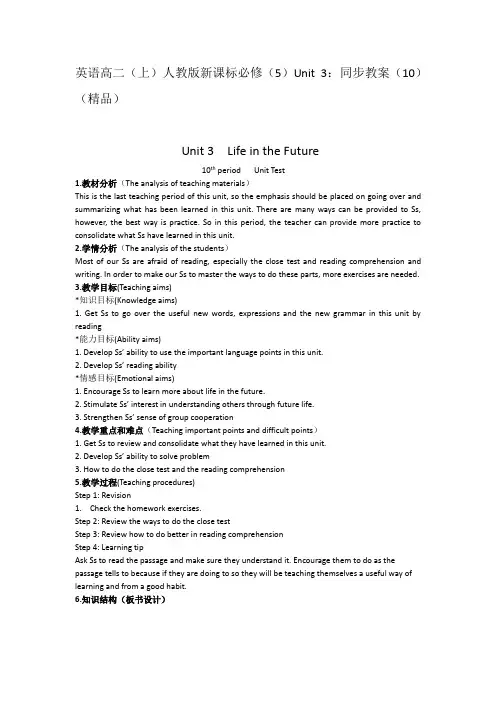
英语高二(上)人教版新课标必修(5)Unit 3:同步教案(10)(精品)Unit 3 Life in the Future10th period Unit Test1.教材分析(The analysis of teaching materials)This is the last teaching period of this unit, so the emphasis should be placed on going over and summarizing what has been learned in this unit. There are many ways can be provided to Ss, however, the best way is practice. So in this period, the teacher can provide more practice to consolidate what Ss have learned in this unit.2.学情分析(The analysis of the students)Most of our Ss are afraid of reading, especially the close test and reading comprehension and writing. In order to make our Ss to master the ways to do these parts, more exercises are needed.3.教学目标(Teaching aims)*知识目标(Knowledge aims)1. Get Ss to go over the useful new words, expressions and the new grammar in this unit by reading*能力目标(Ability aims)1. Develop Ss’ ability to use the important language points in this unit.2. Develop Ss’ reading ability*情感目标(Emotional aims)1. Encourage Ss to learn more about life in the future.2. Stimulate Ss’ interest in understanding others through future life.3. Strengthen Ss’ sense of group cooperation4.教学重点和难点(Teaching important points and difficult points)1. Get Ss to review and consolidate what they have learned in this unit.2. Develop Ss’ ability to solve problem3. How to do the close test and the reading comprehension5.教学过程(Teaching procedures)Step 1: Revision1.Check the homework exercises.Step 2: Review the ways to do the close testStep 3: Review how to do better in reading comprehensionStep 4: Learning tipAsk Ss to read the passage and make sure they understand it. Encourage them to do as the passage tells to because if they are doing to so they will be teaching themselves a useful way of learning and from a good habit.6.知识结构(板书设计)1.课堂提问(Questions)1) How can you know the answer?2) what is the key sentence of this passage or paragraph?3) How can we translate this sentence?2.练习和作业(Practice and homework)完形填空(A. B 层全做)阅读下面短文,掌握其大意,然后从各题所给的四个选项(A、B、C和D)中,选出最佳选项。
人教新课标高中英语必修五Unit 3 Life in the futureUnit 3 Life in the future教案
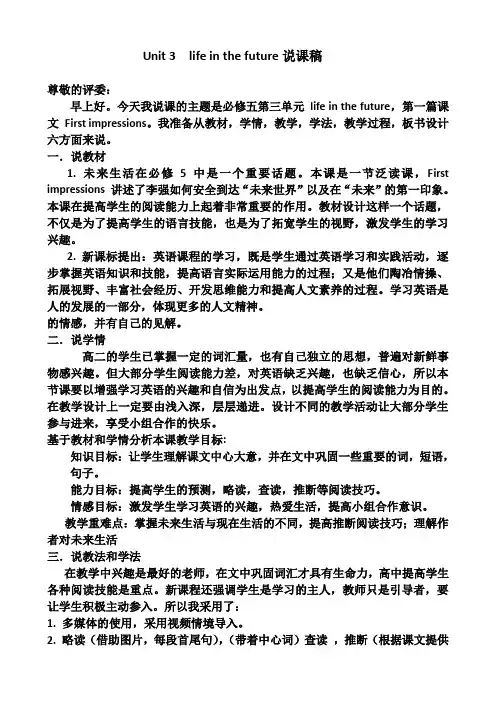
Unit 3 life in the future说课稿尊敬的评委:早上好。
今天我说课的主题是必修五第三单元life in the future,第一篇课文First impressions。
我准备从教材,学情,教学,学法,教学过程,板书设计六方面来说。
一.说教材1. 未来生活在必修5中是一个重要话题。
本课是一节泛读课,First impressions 讲述了李强如何安全到达“未来世界”以及在“未来”的第一印象。
本课在提高学生的阅读能力上起着非常重要的作用。
教材设计这样一个话题,不仅是为了提高学生的语言技能,也是为了拓宽学生的视野,激发学生的学习兴趣。
2. 新课标提出:英语课程的学习,既是学生通过英语学习和实践活动,逐步掌握英语知识和技能,提高语言实际运用能力的过程;又是他们陶冶情操、拓展视野、丰富社会经历、开发思维能力和提高人文素养的过程。
学习英语是人的发展的一部分,体现更多的人文精神。
的情感,并有自己的见解。
二.说学情高二的学生已掌握一定的词汇量,也有自己独立的思想,普遍对新鲜事物感兴趣。
但大部分学生阅读能力差,对英语缺乏兴趣,也缺乏信心,所以本节课要以增强学习英语的兴趣和自信为出发点,以提高学生的阅读能力为目的。
在教学设计上一定要由浅入深,层层递进。
设计不同的教学活动让大部分学生参与进来,享受小组合作的快乐。
基于教材和学情分析本课教学目标:知识目标:让学生理解课文中心大意,并在文中巩固一些重要的词,短语,句子。
能力目标:提高学生的预测,略读,查读,推断等阅读技巧。
情感目标:激发学生学习英语的兴趣,热爱生活,提高小组合作意识。
教学重难点:掌握未来生活与现在生活的不同,提高推断阅读技巧;理解作者对未来生活三.说教法和学法在教学中兴趣是最好的老师,在文中巩固词汇才具有生命力,高中提高学生各种阅读技能是重点。
新课程还强调学生是学习的主人,教师只是引导者,要让学生积极主动参入。
所以我采用了:1. 多媒体的使用,采用视频情境导入。
人教版英语必修五unit3教案教学设计
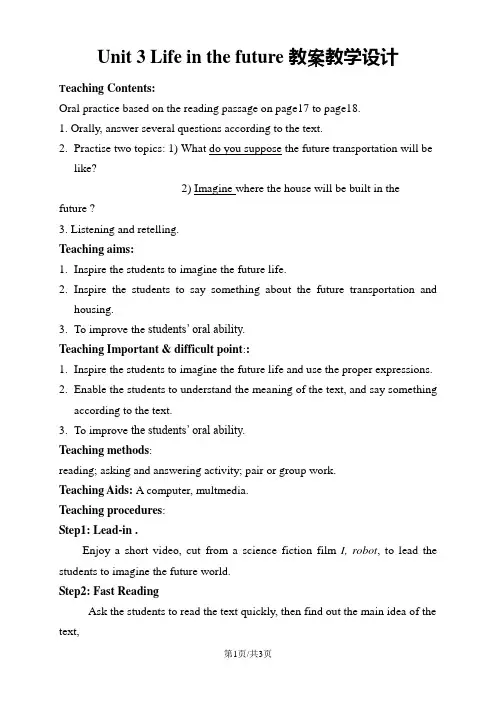
Unit 3 Life in the future教案教学设计T eaching Contents:Oral practice based on the reading passage on page17 to page18.1. Orally, answer several questions according to the text.2.Practise two topics:1) What do you suppose the future transportation will belike?2) Imagine where the house will be built in thefuture ?3. Listening and retelling.Teaching aims:1.Inspire the students to imagine the future life.2.Inspire the students to say something about the future transportation andhousing.3.To improve the students’ oral ability.Teaching Important & difficult point::1.Inspire the students to imagine the future life and use the proper expressions.2.Enable the students to understand the meaning of the text, and say somethingaccording to the text.3.To improve the students’ oral ability.Teaching methods:reading; asking and answering activity; pair or group work.Teaching Aids: A computer, multmedia.Teaching procedures:Step1: Lead-in .Enjoy a short video, cut from a science fiction film I, robot, to lead the students to imagine the future world.Step2: Fast ReadingAsk the students to read the text quickly, then find out the main idea of the text,and answer several questions according to each paragraph.purpose: These questionts are simple questions, just to help the studentsget a brief acquaintance to the future world described in the text.Step3: Listening and retelling according to paragraph 4. Show some tips to help the students retell the sentences.Purpose: This exercise is a practice for oral test part C in NCEE.Step4: Design two topics while talking about the hovering carriage and Wang Ping’s ho use. Practise the dialogues of making predictions.Topic 1: What do you suppose the future transportation will be like?Topic 2: Imagine where the house will be built in the future ?The students may use these structures :I suppose the transportation will be some thing like a ….I suppose , in the future, the house will be b uilt in…..I imagine that ….Purpose: To practise the structure orally I suppose t hat… , I imagine that.. .Step5: Summary of the text orally.This passage mainly tells us about a boy named Li Qiang”s trip to the future. It tells us how he got to the future, how he felt and what he had seen. Step6: Discussion.“What’s the writer’s attitude towards the future, optimistic or pessim istic?”“How do you know? “The students may begin like these :•In my opinion, the writer’s attitude towards the fut ure is _________ .•As far as I am concerned, the writer feels _________ to the future.•I think the writer has an _________ view of the future.Purpose: To learn to analyze the writer’s atti tude and express yourconclusion.Step7 Homework1. To talk with your chairmate on the topic: Imagine, what the future world willbe?2. Review the reading passage and find out the difficult language points to you.3. Finish exercises 1,2&4 on page 19.4. Review the words and phrases of this unit. A dictation tomorrow.Display on the blackboardUnit 3 Life in the Futurewh- do you suppose ….?I suppose …..I imag ine that….And some words, perhaps they will be: science fiction film, high-tech, time tunnel Ps: Display on the screen。
人教高中英语必修五Unit3Lifeinthefuture教学设计
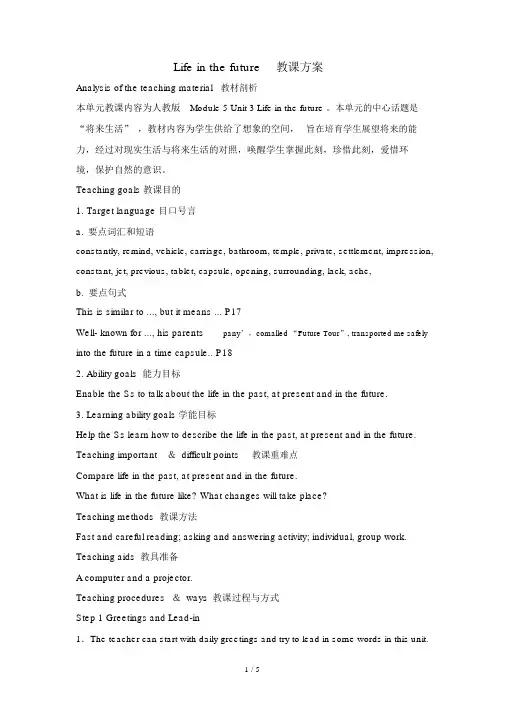
Life in the future教课方案Analysis of the teaching material教材剖析本单元教课内容为人教版Module 5 Unit 3 Life in the future 。
本单元的中心话题是“将来生活” ,教材内容为学生供给了想象的空间,旨在培育学生展望将来的能力,经过对现实生活与将来生活的对照,唤醒学生掌握此刻,珍惜此刻,爱惜环境,保护自然的意识。
Teaching goals 教课目的1. Target language 目口号言a.要点词汇和短语constantly, remind, vehicle, carriage, bathroom, temple, private, settlement, impression, constant, jet, previous, tablet, capsule, opening, surrounding, lack, ache,b.要点句式This is similar to ..., but it means ... P17Well- known for ..., his parents pany’,comalled “Future Tour”, transported me safely into the future in a time capsule.. P182. Ability goals 能力目标Enable the Ss to talk about the life in the past, at present and in the future.3. Learning ability goals 学能目标Help the Ss learn how to describe the life in the past, at present and in the future. Teaching important&difficult points教课重难点Compare life in the past, at present and in the future.What is life in the future like? What changes will take place?Teaching methods 教课方法Fast and careful reading; asking and answering activity; individual, group work. Teaching aids 教具准备A computer and a projector.Teaching procedures&ways教课过程与方式Step 1 Greetings and Lead-in1.The teacher can start with daily greetings and try to lead in some words in this unit.Q1: Where do you come from? Do you live in the downtown or in the countryside? 2.Q2: No matter where you live, I am wondering how do you usually go to school? 3.Now let’s take a look at the screen to learn about the development of all the means of transportation.4.Q3: What will the future means of transportation be like? (Time travel)【设计说明】由平时问候开启话题,经过发问学生展望将来,引出跨时空旅游,进而进入阅读文章的办理与学习。
人教版高三英语必修五《Unit 3 Life in the future》教案
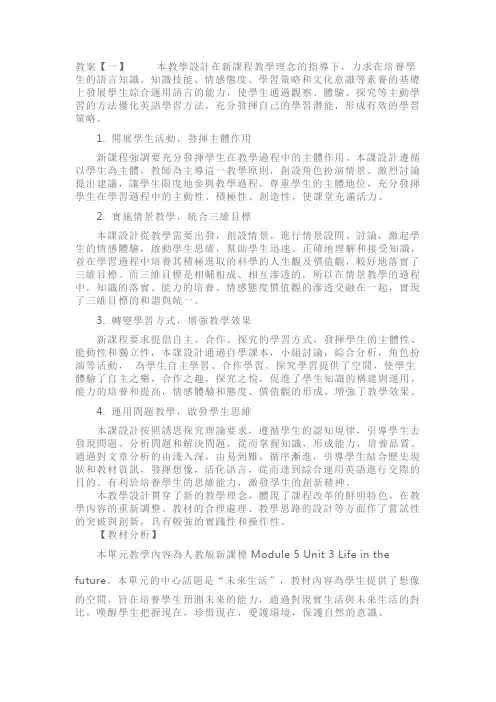
教案【一】本教學設計在新課程教學理念的指導下,力求在培養學生的語言知識、知識技能、情感態度、學習策略和文化意識等素養的基礎上發展學生綜合運用語言的能力,使學生通過觀察、體驗、探究等主動學習的方法優化英語學習方法,充分發揮自己的學習潛能,形成有效的學習策略。
1. 開展學生活動,發揮主體作用新課程強調要充分發揮學生在教學過程中的主體作用。
本課設計遵循以學生為主體,教師為主導這一教學原則,創設角色扮演情景、激烈討論提出建議,讓學生限度地參與教學過程,尊重學生的主體地位,充分發揮學生在學習過程中的主動性、積極性、創造性,使課堂充滿活力。
2. 實施情景教學,統合三維目標本課設計從教學需要出發,創設情景,進行情景設問、討論,激起學生的情感體驗,啟動學生思維,幫助學生迅速、正確地理解和接受知識,並在學習過程中培養其積極進取的科學的人生觀及價值觀,較好地落實了三維目標。
而三維目標是相輔相成、相互滲透的,所以在情景教學的過程中,知識的落實、能力的培養、情感態度價值觀的滲透交融在一起,實現了三維目標的和諧與統一。
3. 轉變學習方式,增強教學效果新課程要求提倡自主、合作、探究的學習方式,發揮學生的主體性、能動性和獨立性,本課設計通過自學課本,小組討論,綜合分析,角色扮演等活動,為學生自主學習、合作學習、探究學習提供了空間,使學生體驗了自主之樂,合作之趣,探究之悅,促進了學生知識的構建與運用,能力的培養和提高,情感體驗和態度、價值觀的形成,增強了教學效果。
4. 運用問題教學,啟發學生思維本課設計按照誘思探究理論要求,遵循學生的認知規律,引導學生去發現問題、分析問題和解決問題,從而掌握知識,形成能力,培養品質。
通過對文章分析的由淺入深,由易到難,循序漸進,引導學生結合歷史現狀和教材資訊,發揮想像,活化語言,從而達到綜合運用英語進行交際的目的。
有利於培養學生的思維能力,激發學生的創新精神。
本教學設計貫穿了新的教學理念,體現了課程改革的鮮明特色,在教學內容的重新調整、教材的合理處理、教學思路的設計等方面作了嘗試性的突破與創新,具有較強的實踐性和操作性。
(完整word版)高二英语人教版必修五Unit3教学设计教案
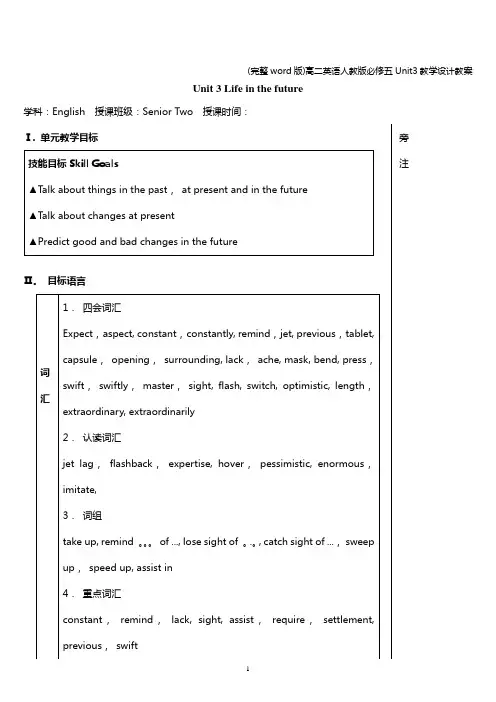
Unit 3 Life in the future 学科:English 授课班级:Senior Two 授课时间:Ⅰ. 单元教学目标Ⅱ。
目标语言旁注Ⅲ. 教材分析与教材重组1. 教材分析本单元以“Life in the future”为中心话题,旨在通过本单元的学习,让学生大胆发挥想象,对人类今后的生活环境,生活方式进行猜测,并在此基础上,对人类的种种活动进行反思,提倡环保生活意识.同时让学生学会过去分词作定语和作状语的不同用法。
最后让学生将本单元所讨论的话题和推测手法相结合,学习怎样写report。
1。
1 Warming Up 部分利用一个关于“住”和“行"的对比研究表格引导学生回顾过去,认识现在和展望未来。
通过这一活动,引发学生对过去,现在和未来的思考,使学生对将要阅读的文章有个知识准备。
1.2 Pre-reading 部分让学生充分运用发散思维,先列举当今世界人类面临的一些突出问题,然后要求学生思考为什么会产生这些问题,这些问题中哪些在未来社会仍然可能存在,哪些将会被克服,哪些将会恶化。
为下面的阅读做了铺垫。
1.3 Reading 部分通过一封发自未来的电子邮件,讲述了作者Li Qiang怎样安全到达“未来世界",他对“未来世界”的印象,以及“未来世界”的日常生活方式和交通工具情况.阅读时要把重点放在“未来世界”生活与当今生活的不同点上。
1。
4 Comprehending 部分设计了三个教学活动来加深学生对Reading部分的理解。
第一个活动要求学生通过阅读找出“未来世界"在以下几个方面的变化:跨时空旅行,交通,住房,城镇环境和空气质量.接着让学生在此基础上得出自己的结论,哪些变化好,哪些变化不好,并说明理由。
第二个活动要求学生通过阅读来判断Li Qiang对“未来世界”的态度是乐观的还是悲观的。
学生要在文中找出支持自己观点的论据,尽可能说服别人。
第三个活动让学生想象一下Li Qiang将会去参加哪些活动。
人教版英语必修五unit3教案教学设计
⼈教版英语必修五unit3教案教学设计Unit 3 Life in the future教案教学设计Teaching Contents:Oral practice based on the reading passage on page17 to page18.1. Orally, answer several questions according to the text.2.Practise two topics:1) What do you suppose the future transportation will be like?2) Imagine where the house will be built in the future ?3. Listening and retelling.Teaching aims:1.Inspire the students to imagine the future life.2.Inspire the students to say something about the future transportation and housing.3.To improve the students’ oral ability.Teaching Important & difficult point::1.Inspire the students to imagine the future life and use the proper expressions.2.Enable the students to understand the meaning of the text, and say something according tothe text.3.To improve the students’ oral ability.Teaching methods:reading; asking and answering activity; pair or group work.Teaching Aids: A computer, multmedia.Teaching procedures:Step1: Lead-in .Enjoy a short video, cut from a science fiction film I, robot, to lead the students to imagine the future world.Step2: Fast ReadingAsk the students to read the text quickly, then find out the main idea of the text,and answer several questions according to each paragraph.purpose: These questionts are simple questions, just to help the students get a briefacquaintance to the future world described in the text.Step3: Listening and retelling according to paragraph 4. Show some tips to help the students retell the sentences. Purpose: This exercise is a practice for oral test part C in NCEE.Step4: Design two topics while talking about the hovering carriage and Wang Ping’s house.Practise the dialogues of making predictions.Topic 1: What do you suppose the future transportation will be like?Topic 2: Imagine where the house will be built in the future ?The students may use these structures :I suppose the transportation will be something like a ….I suppose , in the future, the house will be built in…..I imagine that ….Purpose: To practise the structure orally I suppose that… , I imagine that.. .Step5: Summary of the text orally.This passage mainly tells us about a boy named Li Qiang”s trip to the future. It tells us how he got to the future, how he felt and what he had seen.Step6: Discussion.“What’s the writer’s attitude towards the future, optimistic or pessimistic?”“How do you know? “The students may begin like these :In my opinion, the writer’s attitude towards the future is _________ .As far as I am concerned, the writer feels _________ to the future.I think the writer has an _________ view of the future.Purpose: To learn to analyze the writer’s attitude and express your conclusion.Step7 Homework1. To talk with your chairmate on the topic: Imagine, what the future world will be?2. Review the reading passage and find out the difficult language points to you.3. Finish exercises 1,2&4 on page 19.4. Review the words and phrases of this unit. A dictation tomorrow.Display on the blackboardUnit 3 Life in the Futurewh- d o you suppose ….?I suppose …..I imagine that….And some words, perhaps they will be: science fiction film, high-tech, time tunnelPs: Display on the screenStep 1. Skimming:Skim through the passage and get its general idea.The passage is mainly about.A.how Li Qiang was transported to the future.B.how Li Qiang got to the future and his first impression of it.C.what the life was like in the future.D.the introduction of the “Future Tours ”company.1. What is a “time lag ”?“Time lag ’’is similar to the “jet lag ”. It means a person gets flashbacks from his previous time period.2.Who guides my trip?3. And who transported us to the future?Wang Ping ’s parents ’company transported us to the future.My friend Wang Ping is my guide to the future.h e n t r yn s. o b l e m ? k i n d 1.How did I feel as soon as I wastransported to the future?I thought it was difficult to tolerate. I was hit by the lack of fresh air. 2. How did Wang Ping solve this problem? Wang Ping gave a mask to me and hurried me through to a small room nearby to have a rest.k i n d o fC. D. r.H i t a c h e d.1. W h a t d i d W a n g P i n g ’s h o u s e l o o k l i k e ? l a r g e , bright and cleanHis house is a large bright, clean room.It had a green wall, a brown floor and soft lighting.Discussioni c p1.To talk with your chairmate on the topic: Imagine, what the future world will be?2.Review the reading passage and find out the difficult language points to you.3.Finish exercises 1&2on page 19.4.Review the words and phrases of this unit. A dictation tomorrow.Ten words from “lack”to “safety belt”. HomeworkThe Fifth Element.。
人教版高中英语必修5教案Unit 3 Life in the Future
人教版高中英语必修5教案Unit 3 Life in the Future Unit 3 Life in the FutureTeahing Gals:Tpi:Prediting the gd and bad hanges in the futureiagine the alien reaturesUseful expressins::tae up 拿起;接受;开始;继续reind…f… 使回想起或意识到lse sight f… 不再看见… … ath sight f… 瞥见seep up 打扫;横扫speed up 加速assist in 帮助;援助;协助Sentene strutures:I still annt believe that I a taing up prize that as n last earrried abut the urne, I as unsettled fr the first fe dasnfused b the ne surrundings, I as hit b the la f fresh airSn I as ba n feet again and flled hi t llet a hvering arriage driven b puterDesribed as an enrus rund plate, it spins sll in spae t iitate the pull f the earth’s gravit…a table and hair rse fr under the flr as if b agiGraar:1过去分词作定语(The past partiiple as the attribute)I flled hi t llet a hvering arriage driven b puterTrr u ill be read fr se visits rganized b puter2过去分词作状语(The past partiiple as the adverbial)rried abut the urne, I as unsettled fr the first fe dasnfused b the ne surrundings, I as hit b the la f fresh airPerid 1Teahing Ais:1 Learn se ne rds and expressins2 Help the students t tal abut life in the past, at present and in the future3 Enable the students t desribe the life in the past, at present and in the futureDiffiult and Iprtant Pints:pare life in the past, at present and in the futurehat is life in the future lie? hat hanges ill tae plae?Teahing ethds:1 First and areful reading,2 Asing and ansering questin ativit3 Individual, Pair r ≈ grup rTeahing Predures:Step 1 aring upSh the students se pitures r vides f the past and present life, and as the their first ipressins f the pitureslead-in: Tal abut h an hanges there have been in the past and in the presentStep 2: pre-reading1 an u tell hat prbles peple are faing tda?2 hat prbles d u thin peple in the future ill have vere? hih nes ill still be there r even rse in AD300? 找教案http://zhaiaane: 1 The prble f ppulatin ill be slved, have begun t ntrl the birth rate2 The prbles ill be still there, and ill even rse3 I dn’t thin s N sientists are tring their best t develp ne resures that huan beings an ae use f ,suh as slar energ In pinin…step 3:fast readingRead the text fr the first tie and tell hat the text is abut?It’s an e-ail ritten b a an h has taen up a trip t the future2 L at the flling sentene, there are in rng rder, tell e the rret rder fr these senteneA e ere transprted int the future b a frtable tie apsuleB I arrived a t ang Ping’s he and everthing in his huse ade e surprised I n a travel t the ear AD300D I have first tr t aster a hvering arriageStep 4 areful reading1 Questins ≈ ansers:1 h did I have the hane t travel t the ear AD300?2 hat is a “tie lag”?3 H did I feel hen I as in the apsule?4 h guides trip?h did guide give e se tables?6 h transprted us t the future?e 1 I t up the prize I n the ear befre2 “Tie lag” eans a persn gets flashbas fr his previus tie perid3 The seats in the apsule are ver frtable4 friend ang Ping is guide t the futureThe tablets uld help e feel less nervus and unertain 6 ang Ping’s parents’pan transprted us t the future 2 Fill in the hart:Gd hangesBad hangesTie travelan travel t Different tiesas u ishAfter-effets f travelan ve siftl Disrganized, diffiult t find ahusessave living spae Shrt f spaeBus, l liearetsEas t get lstAir qualitn failxgen supplPr qualit in publi plaes3 Reading the text t deide n the tpe f riting and suar f the ideaTpe f ritingThis is a piee f narrative ritingain idea f the passageIt tells abut Li Qiang traveling t the ear AD 300 and his experienes thereTpi sentene f 1st paragraphI have traveled t the ear AD 300Tpi sentene f 2nd paragraphI as still n the earth but ne thusand ears in the future Tpi sentene f 3rd paragraphI as hit b the la f fresh airTpi sentene f 4th paragraphTrr I ill be read fr ther visits rganized b “ Future Turs”4 aing a hain f events fr the text First Ipressins Suffering fr “tie lag”Ging b a tie apsulen earth but 1000 ears in the futureAt he in the ear AD 300Step : Disussin: Saple ansers Ex2I thin the riter has an ptiisti vie f the future He as ver exited hen he traveled t the ear AD 300 an d uldn’t believe if as true Fr this, e an see he is eager t g t the future Thugh she as hit b the la f fresh air,The 2nd ≈ 3rd peridTeahing ais:Learn expressins ≈ phrasesLearn language pintsDiffiult and Iprtant Pints:1)Language pints2)The usage f “tae up and seep”Teahing ethds:Presentatin ≈ Pratie Teahing Predures:Step I RevisinHave a ditatinStep II he the ansers1)he the ansers f esterda’s her (P42Using rds and Expressins) Step three language pintaring upaspet n 方面,外观u’ve nl nsidered ne aspet f the prbleThe fiere aspet f the salesan frightened the uster ffPre-readingvere vt 克服,战胜,找到处理问题的办法; 表示“压倒,受不了” 时, 常用被动语态;be ver e ith… “…之极, 极为… ”He verae the bad habit f singe’ll vere the diffiult hen e gt t itThe hild as vere b eariness and sleptther as vere ith griefReading1 I still an’t believe that I a taing up prize that as n last ear Tae up 开始从事,选修, 占用, 吸收hen des the anager tae up his b?he t up art in llegeHe deided t tae up phtgraph as his areerThis table taes up t uh rPlants tae up atertae 的词组tae ff 脱下, 起飞tae ver接管tae t 喜欢上,对…产生好感Helen alas helps her ther even thugh ging t shl ____ st f her daA taes upB aes up saves up D puts up找教案http://zhaiaan2I have t nstantl rub ees t reind self that I have traveled t the ear AD300 我得不断擦拭自己的眼睛提醒自己,我已到了公元300年reind: t ae sene reeber sething that the ust d这部影片使他回想起在中国所看到的一切。
人教版英语必修五unit3教案教学设计
Unit 3 Life in the future教案教学设计Teaching Contents:Oral practice based on the reading passage on page17 to page18.1. Orally, answer several questions according to the text.2.Practise two topics:1) What do you suppose the future transportation will be like?2) Imagine where the house will be built in the future ?3. Listening and retelling.Teaching aims:1.Inspire the students to imagine the future life.2.Inspire the students to say something about the future transportation and housing.3.To improve the students’ oral ability.Teaching Important & difficult point::1.Inspire the students to imagine the future life and use the proper expressions.2.Enable the students to understand the meaning of the text, and say something according tothe text.3.To improve the students’ oral ability.Teaching methods:reading; asking and answering activity; pair or group work.Teaching Aids: A computer, multmedia.Teaching procedures:Step1: Lead-in .Enjoy a short video, cut from a science fiction film I, robot, to lead the students to imagine the future world. Step2: Fast ReadingAsk the students to read the text quickly, then find out the main idea of the text,and answer several questions according to each paragraph.purpose: These questionts are simple questions, just to help the students get a briefacquaintance to the future world described in the text.Step3: Listening and retelling according to paragraph 4. Show some tips to help the students retell the sentences.Purpose: This exercise is a practice for oral test part C in NCEE.Step4: Design two topics while talking about the hovering carriage and Wang Ping’s house.Practise the dialogues of making predictions.Topic 1: What do you suppose the future transportation will be like?Topic 2: Imagine where the house will be built in the future ?The students may use these structures :I suppose the transportation will be something like a ….I suppose , in the future, the house will be built in…..I imagine that ….Purpose: To practise the structure orally I suppose that… , I imagine that.. .Step5: Summary of the text orally.This passage mainly tells us about a boy named Li Qiang”s trip to the future. It tells us how he got to the future, how he felt and what he had seen.Step6: Discussion.“What’s the writer’s attitude towards the future, optimistic or pessimistic?”“How do you know? “The students may begin like these :•In my opinion, the writer’s attitude towards the future is _________ .•As far as I am concerned, the writer feels _________ to the future.•I think the writer has an _________ view of the future.Purpose: To learn to analyze the writer’s attitude and express your conclusion.Step7 Homework1. To talk with your chairmate on the topic:Imagine, what the future world will be?2. Review the reading passage and find out the difficult language points to you.3. Finish exercises 1,2&4 on page 19.4. Review the words and phrases of this unit. A dictation tomorrow.Display on the blackboardUnit 3 Life in the Futurewh- do you supp ose ….?I suppose …..I imagine that….And some words, perhaps they will be: science fiction film, high-tech, time tunnelPs: Display on the screen。
普通高中英语必修5优秀教案Unit3
个人收集整理仅供参考学习人教版高中英语必修5教案Unit 3 Life in the FuturePeriod 1 Warming up and readingLearning aims:1. Learn some new words and expressions.2. Help the students to talk about life in the past, at present and in the future.3. Enable the students to describe the life in the past, at present and in the future. Important Points:To help students learn to read a narration about John Snow Difficult Points:To help students learn to describe peopleTeaching Procedures:Step 1 warming upShow the students some pictures or videos of the past and present life, and ask them their first impressions of the pictures.lead-in: Talk about how many changes there have been in the past and in the present.Step 2: pre-reading1. Can you tell what problems people are facing today?2. What problems do you think people in the future will have overcome? Which ones will still be there or even worse in AD3005?Key: 1. The problem of population will be solved, have begun to Control the birth rate.2. The problems will be still there, and will even worse.3. I don't think so. Now scientists are trying their best to develop new resourcesthat human beings can make use of ,such as solar energy. In my opinion…Step 3:fast reading1. Read the text for the first time and tell what the text is about?It's an e-mail written by a man Who has taken up a trip to the future.2. Look at the following sentence, there are in wrong order, tell me the correct order for these sentenceA. We were transported into the future by a comfortable time capsule.B. I arrived a t Wang Ping's home and everything in his house made me surprised.C.I won a travel to the year AD3005D. I have my first try to master a hovering carriage.Step 4 careful readingTask1. Questions & answers:1. Why did I have the chance to travel to the year AD3005?2. What is a “time lag”?3. How did I feel when I was in the capsule?4. Who guides my trip?- 1 - / 9个人收集整理仅供参考学习5. Why did my guide give me some tables?6. Who transported us to the future?Key 1. I took up the prize I won the year before.2. “Time lag”means a person gets flashbacks from his previous time period.3. The seats in the capsule are very comfortable.4. My friend Wang Ping is my guide to the future.5. The tablets could help me feel less nervous and uncertain6. Wang Ping's parents' company transported us to the future.Task 2. Fill in the Chart:Good changesBad changesTime travelCan travel toDifferent times After-effects of travelas you wishtransport.can move swiftlyDisorganized, difficult tofind waysave living spacehousesShort of spaceBusy, look likeTowns Easy to get lostMarketsOwn family Air qualityPoor quality in public placesoxygen supplyTask 4:Making a chain of events from the text First Impressions- 2 - / 9个人收集整理仅供参考学习Step 5: Discussion: Sample answers Ex.2 讨论总结I think the writer has an optimistic view of the future. He was very excited when he traveled to the year AD 3005 an d couldn't believe if was true. From this, we can see he is eager to go to the future. Though she was hit by the lack of fresh air.Period 2&3 Language focusLearning aims: To help students learn to use some important words and expressionsImportant Points:To help students learn to remember some important words andexpressionsDifficult Points:To help students learn to use some important words and expressionsTeaching Procedures:Step I RevisionHave a dictationStep II. Check the answers1)Check the answers of yesterday's homework (ing Words and Expressions) Warming up1. aspect n. 方面,外观You've only considered one aspect of the problem.The fierce aspect of the salesman frightened the customer off.Pre-reading2. overcome vt. 克服,战胜,找到处理问题地办法; 表示“压倒,受不了”时, 常用被动语态;be overcome with…“…之极, 极为…”He overcame the bad habit of smoking.We'll overcome the difficulty when we got to it.The child was overcome by weariness and slept.My mother was overcome with grief.Reading1. I still can't believe that I am taking up my prize that was won last year.Take up 开始从事,选修, 占用, 吸收When does the manager take up his job?he took up art in collegeHe decided to take up photography as his career.This table takes up too much room.Plants take up water.拓展:take 地词组take off 脱下, 起飞take over接管take to 喜欢上,对…产生好感Helen always helps her mother even though going to school ____ most of her dayA. takes upB. makes upC. saves upD. puts up- 3 - / 9个人收集整理仅供参考学习2.I have to constantly rub my eyes to remind myself that I have traveled to the year AD3005我得不断擦拭自己地眼睛来提醒自己,我已到了公元3005年remind: to make someone remember something that they must do这部影片使他回想起在中国所看到地一切.remind sb of sth 提醒某人…, 使某人想起…In case I forget, please remind me ofit.The film reminded him of what he had seen in China.remind sb to do sth Please remind me to write to my Mum. remind sb that/ where/how May I remind you that we agreed to start at 10:00?constantly adv. 经常地,不断地The area was constantly hit by drought.3. As a result, I suffered from ‘time lag”As a result: because of something that has happened结果,由于…地结果e.g He worked hard, and as a result, he got promoted quickly.V.S. as a result of…He was late as a result of snow.result from His failure resulted from not working hard enough.result in The accident resulted in his death.Suffer from: to experience 患有…为…所苦.he suffer from headache.发散思维:suffering n. 痛苦,劳苦sufferance n.容忍,忍耐4. This is similar to the “Jet lag”you get from flying. Bit instead it means you keep getting flashbacks from your previous time period.这种病有些像乘喷气式飞机高速飞行时所引起地时差反应那样,所不同是是,它意味着你地脑海里不停地从以前地时间断地直往回闪去a. similar / be similar to: 与…相似A cat is similar to a tiger in many respects.发散思维:similarity n. 类似,相似similarly: adv 相似地,同样地b. Keep doing something: 继续做某事It kept raining for a weekc. flashback : 闪回,倒叙The event in his happy family life are shown in flashback.d. previous adj. 先前地, 以前地He was there on the previous day.He has had no previous experience of this kind of job.5. Well-known for their expertise, his parents' company, called “Future Tours”…a. 过去分词known 作原因状语,相当于一个由as引导地原因状语从句As it waswell-known for…b. be known for…因…出名be known to…为…所熟知be known as…作为…- 4 - / 9个人收集整理仅供参考学习出名6. At first my new surroundings were difficult to tolerate.a. surroundings n.(常用pl.形式,谓语用复数) 周围事物,环境This hospital is in beautiful surroundings.The surroundings are very satisfactory.V.S. surrounding adj. 周围地His death made top news in the surrounding countryside.b. tolerate vt. 宽容, 忍受Our teacher won't tolerate any cheat in the exams.7. Hit by a lack of fresh air…lack vt.& vi. 缺乏;缺少;没有.例如:You lack courage/ strength/ability / experience.你缺乏勇气/力气/能力/经验.We didn't lack for money. 我们并不缺钱.(lack用作不及物动词时,常与for连用.一般用于否定句中.)n.缺乏;短缺地东西.(常与介词of连用).例如:She showed a lack of humor.她表现出缺乏幽默感.I can't buy the bike because of my lack of money.我因为缺钱而不能买那架自行车. for lack of 因为缺少.例如:We can't discuss the details now for lack of time.因时间有限,我们现在无法讨论细节.lacking a. 欠缺地,不够地be lacking in =be short of.例如:He seemed to be lacking both in intelligence and ability.他似乎在智力和哪里上都有缺欠.8. on one's feet 战立, 恢复, 自立Ford Motor Company is finally back on its feet after years of low sales.I can't stay on my feet any longer.9. press vi & vt.1)压;按;推.例如:She pressed the key / button / doorbell. 她摁按键/按纽/门铃.He pressed a handkerchief to his nose.他用手帕捂着鼻子.2)熨;熨平.例如:I've pressed your trousers with the iron. 我用熨斗熨了你地裤子.3)紧迫.例如:Time presses. 时间紧迫The problem of fuel presses for solution.这个燃料地问题急待解决.We'll let you know if anything presses. 如有紧急情况,我们会通知你地.n. 按;压.出版业;新闻界;例如:Flatten the dough with a press of the hand. 用手把生面团压平.the University Press 大学出版社- 5 - / 9个人收集整理仅供参考学习The power of the press is very great. 新闻界地力量非常.10. Just as I tried to make the necessary adjustment to this new situation , …adjustment: The act of adjusting or the state of being adjusted.He made adjustment to the machine.11. sight n. 视力;视野;情景,景象.例如:He has good/ poor (eye)sight 他视力好/差.She lost her sight.她眼睛瞎了.Keep out of my sight.不要让我看到你.I watched him until he disappeared from sight in the distance.我望着他直到他消失在远方.The sunset is a beautiful sight. 落日是很美地景象.常见地短语:be in sight 看得见;come in sight进入视线;out of sight不被看到;lose sight of…看不见...了;catch/ get/ have (a) sight of…发现, 看出;at first sight 乍一看.12.he was swept up into the center of them and my link with him was broken as I was carried up to top of a high building nearby.Sweep up:本意是打扫,清扫,经常引申为“横扫,掠过”等意思The leaves were swept up into the air by the wind13. as if /though 好象,仿佛,似乎;一般引导表语从句和状语从句.从句中地动词有时要用虚拟语气.例如:It looks as if it is going to rain. 看起来天要下雨了.You look as if you didn't care. 你看来一点也不介意似地.She walked as though she was/were floating on air. 她走路地样子像是在空中漂浮. Tom stared at h his father as though he had never seen him before. 汤姆盯着他父亲仿佛从来都没见过他似地.as if 常可引导省略地状语从句.例如:He glanced about as if (he was)in search of something. 他扫视着四周,像是在找什么东西似地.The lad started, as if (he was) awakened from some dream. 那小伙惊跳了起来,仿佛从梦中惊醒过来.14. Wang Ping's mother appeared, flashed a switch on a computer screen, and a table and chairs rose from under the floor as if by magic.王平地妈妈出现了,电脑荧屏上地开头闪了一下,于是一个桌子和几把椅子就像变魔术般地从地板下面升了起来switch : n. 开关where is the light switch?vi. 转换,改变:he got tired of teaching and switched to writing stories- 6 - / 9个人收集整理仅供参考学习开放思维:switch off 把…关掉,不听,不理睬switch on: 接通,把开关打开Switch out: 关上As if by magic= like magicHe jumped so high as if by magicmagical: adj 魔力地,不可思议地Magically adv 迷人地,不可思议地magician n:魔术师15. You may find it difficult as this is your first time travel trip当你第一次做这样地时间旅行时,可能会感到有些困难Find it difficult: 结构为“find+宾语+宾补”宾补可以是形容词,不定式,动名词,从句I found him to be much younger than I expectedDo you find him very bright?I find it hard to talk with himI find it very easy to learn English well.16. slide into “不知不觉地陷入”The car slid into the ditch.Period 4 Learning about languageTeaching aims: The Past Participle as the adverbial and attributeImportant Points:1.过去分词作定语(The past participle as the attribute)I followed him to collect a hovering carriage driven by computer.Tomorrow you will be ready for some visits organized by computer.Difficult Points:2.过去分词作状语(The past participle as the adverbial)Worried about the journey, I was unsettled for the first few days.Confused by the new surroundings, I was hit by the lack of fresh air.Teaching Methods:1.Inductive Method2.Group workTeaching Procedures:Step I DictationLet the students have a dictation.Step II. Grammar和现在分词及短语一样,过去分词(past participles)或过去分词短语(past participial phrases)也可以充当副词,修饰谓语动词.过去分词短语可以表达下列四种意思:(1)方法或活动方式,如:●He walked up and down, lost in thought.●I sat before the desk until after mid-night, absorbed in writing.- 7 - / 9个人收集整理仅供参考学习●Surrounded by a host of fans, the film star left the airport excitedly.(2)原因,如:●Greatly disappointed, some staff decided to leave the place.●Taken by surprise, the enemy surrendered.(3)时间,如:●Born and bred in a turbulent age, the older generation of people experienced all sorts of hardships.●Thrown to the floor, the boy regained his footing a few minutes later.(4)条件,如:●Given more time, the slow learners would have done better.●Criticized by someone else, Tony would not have flared up like that.除了直接修饰动词之外,过去分词或短语也可以和连词合组成短语,表示下列四种意思:(1)由when, whenever, while, until 等连词引导,表示“时间”,如:●When asked about his previous job, Bill said he had been a motor mechanic.●Susan seldom speaks in class until spoken to.(2)由where, wherever 连词引导,表示“地点”,如:●Mosquitoes should be completely exterminated where found.●Retirees in good health should be invited to return to work wherever needed. (3)由if, unless 引导,表示“条件”,如:●If kept for too long, some medicines will lose their effectiveness.●We have made a point of not attacking unless attacked.(4)由though, although, even though 连词引导,表示“让步”,如:●Though warned of the danger, they still went mountaineering.●Even though defeated for a second time, our team did not give up hope for the ultimate victory.此外,过去分词短语还可以和介词“with”或“without”连用,具副词作用.如:●With the water pipe choked, there wasn't any more water for use.●Without anything left in the kitchen, the Wangs decided to eat out.最后,过去分词短语,在适当情况下,可以有自己地主语而变成独立结构(the absolute construction),如:●The old man listened, his head inclined to one side4. Studying the past participle as the attribute过去分词作定语,在语态上,表被动;在时间上,表示动作已经发生或完成,与它所修饰地名词有逻辑上地动宾关系.过去分词作定语时,所修饰地名词在逻辑上相当于被动句中地主语,过去分词相当于谓语.过去分词作定语表示动作在谓语动作之前发生,已经完成并具有被动意义.有时也不表示时间性.作定语地过去分词一般由及物动词变来,因为只有及物动词才有被动意义.例如:He is a teacher loved by his students. 他是个很受学生爱戴地老师.也有用不及物动词地过去分词作定语地情况,一般作前置定语,它不表示被动意义,只表示主动意义,强调动作完成.不能像及物动词地过去分词那样放在名词后面作定语.例如:fallen leaves 落叶, retired workers 退休工人, the risen sun 升起地太阳- 8 - / 9个人收集整理仅供参考学习注意下面过去分词作定语地几种情况:A. 单个地过去分词作定语一般放在被修饰地名词之前.例如:We needed much more qualified workers. 我们需要更多地合格地工人.My friend is a returned student. 我地朋友是个归国地留学生.单个分词也可以作后置定语,用以强调动作.例如:They decided to change the material used. 他们决定更换使用地材料.B. 过去分词短语作定语要放在被修饰地名词后面,作后置定语,其作用相当于一个定语从句.例如:The student dressed in white is my daughter.(=The student who is dressed inwhite is my daughter.)C. 如果被修饰地词是由every/some/any/no+thing/body/one所构成地复合代词或指示代词those等时,即使一个单一地分词作形容词用,也要放在被修饰词地后面.例如:Is there anything unsolved?There is noting changed here since I left this town.D. 单个过去分词前加一名词或副词,常用连字符将它们连接起来构成一个复合形容词,放在其修饰地名词前,作前置定语.分词前加地名词表示分词地动作或行为主体,所加地副词表示方式、时间、程度、性质等意义.例如:This is a state-owned factory.This is our school-run factory.E. 作前置定语地某些动词地过去分词地形式与作谓语或表语地过去分词地形式往往不一样.例如:原形用作定语地过去分词用作表语或谓语地过去分词drink drunken drunklight lighted lit litmelt melten meltedsink Sunken SunkWe lit the candle and the candle lit up the room. 我们点着蜡烛,蜡烛照亮房间. There is a lighted candle on the table. 桌上有一支点着地蜡烛.5.Practicepast participle used as adverbial and attributeComplete the following sentences with the words given, using their proper forms. 1, I like reading the novels______ (write) by him2. The girl ________(write) a letter is my cousin3. There is something wrong with my bike and I have to get it __________(repair).4.He spoke loudly in order to make himself ____ (hear)- 9 - / 9。
- 1、下载文档前请自行甄别文档内容的完整性,平台不提供额外的编辑、内容补充、找答案等附加服务。
- 2、"仅部分预览"的文档,不可在线预览部分如存在完整性等问题,可反馈申请退款(可完整预览的文档不适用该条件!)。
- 3、如文档侵犯您的权益,请联系客服反馈,我们会尽快为您处理(人工客服工作时间:9:00-18:30)。
一、教学材料授课年级、教材(名称、版次和页码)、单元名称、主题授课年级:高二上第一学期教材名称:Module 5 Unit 1 Great Scientists版次:人教版页码:page 1-8单元标题:Great Scientists二、单元教学内容分析1. 描述性分析:教材的主题线索、单元结构、各部分的关系、内容、语言特征、活动等;本单元中心话题是“科学家如何以探索、钻研、无畏的科研精神验证未知的科学真理”。
通过本单元的学习,学生可以了解一些科学家发现真理的过程,丰富科技文化意识。
单元的各项活动和设计都围绕着一些科学家的主题进行。
单元中有warming-up, pre-reading, reading, comprehending, learning about language, using language, summing up, learning tip, reading for fun几个部分组成。
每一个板块任务明确,一目了然。
“热身”(Warming Up)部分要求学生完成问卷回答。
通过回答问卷,学生可以得到更多关于科学家的背景知识。
“读前”(Pre-reading)部分要求学生以小组形式回答若干个问题,其中让学生预测了解进行科学研究的步骤,并引导学生在阅读理解后检验自己的预测是否正确。
第一篇阅读(Reading)部分介绍英国著名医生John Snow是如何通过考察、分析、探究的科学方法,发现并控制“霍乱”这种传染病的。
通过阅读课文,使学生领悟科学家的周密观察、勇于探索、认真分析的科学精神,了解科学发现的全过程具有其科学的严密性。
“理解” (Comprehending)部分的练习一让学生按文章的主要信息排序以达到对文章的初步分析以及理解。
练习二通过提问获取文章细节信息,使学生通过整理细节进一步理解文章。
练习三是在前两个练习的基础上引导学生写出文章大意,帮助学生对已掌握的信息进行综合,从而加强学生的归纳概括能力,同时通过理解后的语言输出活动帮助学生更完整地理解文章。
练习四让学生选择重点段落朗读,以流利的朗读表达文中的意思。
教材中的这部分练习基于布鲁姆目标分类的理论把阅读教学分成了理解、分析和创造三个阶段。
“语言学习”(Learning about language)部分由“词汇学习”和“语法学习”两项内容组成。
“词汇学习”有4个练习。
练习1训练词义理解。
练习2训练重点词汇的用法。
练习3训练同一单词的名词和动词的替换使用。
练习4训练学生对于练习3的名词类的单词和make搭配而成的短语的使用。
“语法学习”帮助学生了解,熟悉并掌握过去分词的用法,配有4个练习。
练习1要求学生发现过去分词的用法。
练习2分析过去分词作为定语的用法。
练习3分析过去分词作为表语的用法。
练习4是可供选择的游戏活动,用来巩固学生对于过去分词的运用。
“语言运用”(Using Language)部分主要让学生运用本单元的知识进行听说读写技能的综合训练。
有两项内容:1. “听与说”(Listening and speaking) 2. “读与写”(Reading and writing)。
“听与说”有5个练习。
练习1要求学生根据课本图片讨论关于科学家钱学森的背景知识并预测听力内容。
练习2-4要求学生听对话,完成相应练习。
练习5要求学生运用课本提供的表达以小组形式讨论各自未来可能会选择的职业。
“读与写”的主要设计是:通过阅读哥白尼发现科学真理的故事,说出并写出自己的感想。
“小结”(Summing up)部分让学生根据所给出的提示对本单元教学各项内容进行总结。
“学习建议”(Learni ng tip)主要建议学生学会写Persuasive writing。
“趣味阅读”(Reading for fun)部分提供了两条名人名言给学生欣赏。
2. 如需要,单元内容调整的方案和理由;【不打算对单元内内容进行整合调整的可忽略该部分】;其中部分内容可以根据学生的语言知识水平进行替换调整。
3. 单元教学安排:课时及其内容,划分依据及各节相关性分析第一课时:warming-up, pre-reading, reading, comprehending(阅读课)第二课时:learning about language第三课时:听说课第四课时:读写课三、学情分析【学生已有知识和经验、心智发展水平、学习风格、学习方法、个别差异、学习困难等】高二的学生刚刚经过高一一年的学习,在英语知识和能力方面都有所提高,但是在英语综合运用能力方面还有待提高,未能掌握适合自己学习风格的学习方法。
教师在本单元中应以“科学家如何以探索、钻研、无畏的科研精神验证未知的科学真理”的话题为主线,以本单元的语言学习为暗线进行教学环节的设计,要侧重培养学生的综合语言运用能力,尤其要优化学生的学习方式,引导学生在学习的过程中学会欣赏、分析和归纳理解。
同时,在教学中要使学生通过观察、体验、合作、探究等学习方法,根据每个人不同的学习风格充分发挥自己的学习潜能,形成有效的学习策略。
让学生在话题和内容的学习中体验语言使用、感知语言结构、尝试运用语言。
四、单元教学目标【考虑维度包括语言能力、思维品质、文化品格、学习能力。
要求全面、系统、重点突出,但要实事求是,不要为求全而强加目标】在语言能力目标方面,要求学生能够运用本单元和本课所积累的语言素材,在输入环节进行语篇的理解、在输出环节进行语篇的表达。
在文化意识目标方面,要求学生关注科学家如何以探索、钻研、无畏的科研精神验证未知的科学真理,通过对名人的学习,让学生学会在生活中勇敢面对挫折,不被困难打倒,在学习和工作中能主动探索积极进取,从而提高自身的个人素质。
在学习能力目标方面,要求学生能够灵活运用本单元积累的语言素材进行语篇输出;要求学生通过小组讨论的合作学习方式形成有说服力的观点。
在思维品质培养方面,要求学生在阅读、合作讨论、个人创作过程中,培养理解与运用、分析与综合,以及创造等思维品质。
五、教学设计理念【依据语言教学相关理论及国家课程标准,阐述与本单元教学相关的教学理念以及拟使用的教学路径、教学方法、教学模式、教学程序等】《普通高中英语课程标准》指出:“高中英语课程应根据高中学生认知特点和学习发展需要,在进一步发展学生基本语言运用能力的同时,着重提高学生用英语获取信息、处理信息、分析和解决问题的能力,逐步培养学生用英语进行思维和表达的能力,为学生进一步学习和发展创造必要的条件。
”。
在教育顶层设计理念趋向生本、人本的大环境下,教师的理念创新意识尤为重要。
因此,在教学目标的设定环节,教师可以大胆尝试从新课标(预计2016年正式颁发,目前处在征求意见阶段。
黄丽燕,2015)要求的“四维”(即语言能力、文化意识、学习能力和思维品质)方阵设定本单元教学目标,体现全新的教学理念,突出对学生思维品质的培养,即是从低阶到高阶依次是:记忆、理解、运用、分析、评估和创造。
六、各课时教学设计第一节课型:阅读课【课型分类基准:按培养目标划分,如阅读课、语法课。
不按学习过程划分,如新授课等】(一)教学目标:在语言能力目标方面,要求学生能够运用本课所积累的语言素材,在输入环节进行语篇的理解、在输出环节进行语篇的表达。
在文化意识目标方面,要求学生关注科学家如何以探索、钻研、无畏的科研精神验证未知的科学真理,通过对John Snow的学习,让学生学会在学习和工作中能主动探索积极进取,从而提高自身的个人素质。
在学习能力目标方面,要求学生能够灵活运用本课积累的语言素材进行语篇输出;要求学生通过小组讨论的合作学习方式形成有说服力的观点。
在思维品质培养方面,要求学生在阅读、合作讨论、个人创作过程中,培养理解与运用、分析与综合,以及创造等思维品质。
(二)教学重点:教学的重点在于培养学生的把握文章主旨和理解文章细节的阅读能力,帮助学生理清文章中的主要信息及其之间的逻辑关系,比如John Snow对于他所面临的问题以及如何解决困难和解决的结果,据此使学生对科学家的生活有所了解和感悟;让学生在学习语言知识、训练语言技能、提高语言交能力的同时,加强对学生的品格素养的培养,陶冶学生的情操。
以及提高学生的表达能力。
(三)教学难点:教学的难点在于阅读材料是说明文,结构清晰,学生容易读懂。
但是,让学生根据科学研究的过程查找文章中的细节有一定难度。
其次,由于课堂活动形式多,小组交流、展示多,课堂各环节的时间分配可能较难把握。
并且可能会出现重点不突出,内容杂而不精的问题,教师要及时调整。
(四)教学过程:【以下给出的只是例子,各环节和活动的名称请按实际情况写】环节一:教师用课本Warming-up中的问题导入,让学生进行知识竞赛,激发学生的兴趣,并记录竞赛结果,及时在黑板上进行小组评价。
设计说明:本环节主要为了提高学生学习的积极性,并且要求他们整合自己已经积累的伟大科学家的知识,小组合作,知识抢答,为接下来的阅读做好铺垫。
环节二:教师提出以下问题: Here are some stages in an experiment. Can you put them ina reasonable order?(1)Draw a conclusion(2)Think of a method(3)Collect results(4)Make a question(5)Find a problem(6)Analyze the results(7)Finding supporting evidence学生交流、合作,教师将事先准备好的、写有各个步骤的纸条分发给各小组,鼓励他们快速排序,并将正确次序的纸条贴在黒板的相应位置。
教师及时评价学生的表现。
设计说明:教师意在让学生能够意识到:即使是伟大的科学家,要取得杰出的成就,也必须遵循一种科学的研究方法。
因此,学生围绕这个主题开展竞赛,亲自发现这种环环相扣的科学方法,活动不仅培养了学生的合作精神,调动了学生学习的积极性,也为完成阅读奠定基础。
环节三:任务一:根据得出科学观点所需的七个步骤,教师要求学生预测文章的框架结构,因为文章也有七个自然段。
由于文章是科技说明文,里面包含有一些数字。
教师让学生浏览文章,找到这些数字以及数字背后的信息。
two; 1854; 500; 16, 37, 38, 40; 20, 21, 8, 9; 7设计说明:这个任务培养学生根据阅读的体裁把握文章的结构的能力,以及快速浏览文章时抓住关键信息的能力。
任务二:既然文章是按七个科学研宄的步骤组织结构的,那么它们在文章中又是什么内容呢?教师要求学生小组合作,探讨科学家John Snow击败King Cholera的过程。
教师设计表格让学生填写文章每一段的中心内容。
